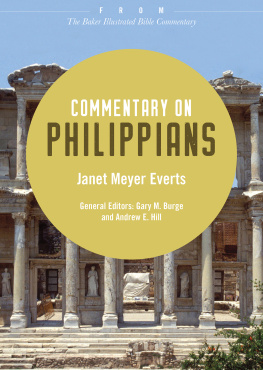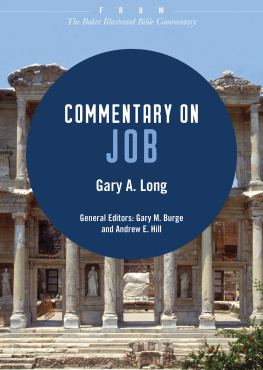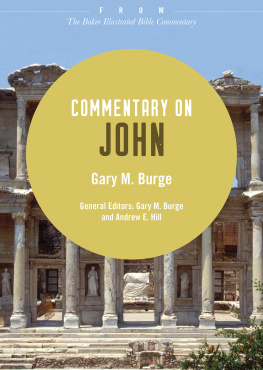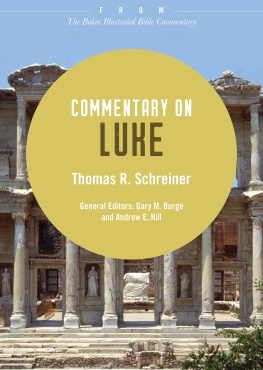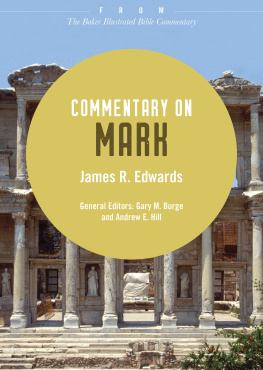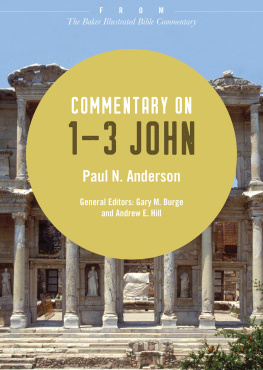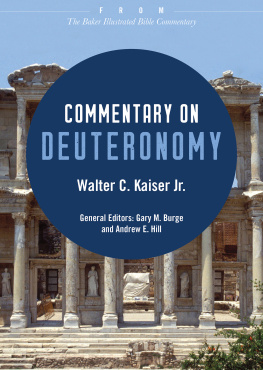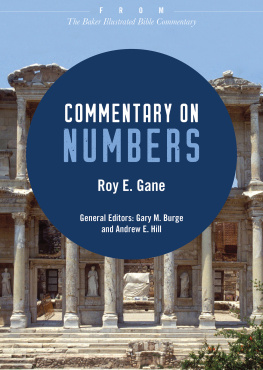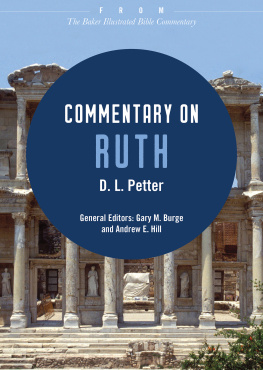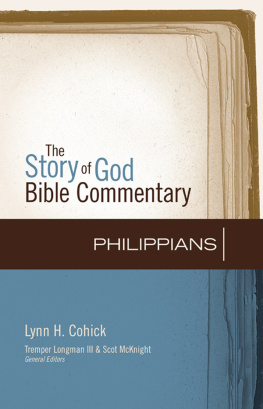Copyright Page
2012 by Baker Publishing Group
Published by Baker Books
a division of Baker Publishing Group
P.O. Box 6287, Grand Rapids, MI 49516-6287
www.bakerbooks.com
Ebook short created 2019
Previously published in The Baker Illustrated Bible Commentary edited by Gary M. Burge and Andrew E. Hill in 2012
All rights reserved. No part of this publication may be reproduced, stored in a retrieval system, or transmitted in any form or by any meansfor example, electronic, photocopy, recordingwithout the prior written permission of the publisher. The only exception is brief quotations in printed reviews.
Library of Congress Cataloging-in-Publication Data is on file at the Library of Congress, Washington, DC.
ISBN 978-1-4934-2472-6
Unless otherwise indicated, Scripture quotations are from the Holy Bible, New International Version. NIV. Copyright 1973, 1978, 1984, 2011 by Biblica, Inc. Used by permission of Zondervan. All rights reserved worldwide. www.zondervan.com. The NIV and New International Version are trademarks registered in the United States Patent and Trademark Office by Biblica, Inc.
Scripture quotations labeled ESV from The Holy Bible, English Standard Version (ESV), copyright 2001 by Crossway, a publishing ministry of Good News Publishers. Used by permission. All rights reserved. ESV Text Edition: 2007
Scripture quotations labeled NASB are from the New American Standard Bible, copyright 1960, 1962, 1963, 1968, 1971, 1972, 1973, 1975, 1977, 1995 by The Lockman Foundation. Used by permission. www.lockman.org
Scripture quotations labeled NIV 1984 are from the HOLY BIBLE, NEW INTERNATIONAL VERSION. NIV. Copyright 1973, 1978, 1984 by International Bible Society. Used by permission of Zondervan. All rights reserved.
Scripture quotations labeled NJPS are from the New Jewish Publication Society Version 1985 by The Jewish Publication Society. All rights reserved.
Scripture quotations labeled NKJV are from the New King James Version. Copyright 1982 by Thomas Nelson, Inc. Used by permission. All rights reserved.
Scripture quotations labeled NLT are from the Holy Bible , New Living Translation, copyright 1996, 2004, 2007 by Tyndale House. Used by permission of Tyndale House Publishers, Inc., Carol Stream, Illinois 60188. All rights reserved.
Scripture quotations labeled NRSV are from the New Revised Standard Version of the Bible, copyright 1989, by the Division of Christian Education of the National Council of the Churches of Christ in the United States of America. Used by permission. All rights reserved.
Scripture quotations labeled RSV are from the Revised Standard Version of the Bible, copyright 1952 [2nd edition, 1971] by the Division of Christian Education of the National Council of the Churches of Christ in the United States of America. Used by permission. All rights reserved.
Unless otherwise indicated, photos, illustrations, and maps are copyright Baker Photo Archive.
Contents
Abbreviations
| ANET | Ancient Near Eastern Texts Relating to the Old Testament . Edited by J. B. Pritchard. 3rd ed. Princeton, 1969 |
| BDAG | Bauer, W., F. W. Danker, W. F. Arndt, and F. W. Gingrich. Greek-English Lexicon of the New Testament and Other Early Christian Literature. 3rd ed. Chicago, 1999 |
| ca. | circa (about, approximately) |
| cf. | compare |
| chap(s). | chapter(s) |
| COS | The Context of Scripture . Edited by W. W. Hallo. 3 vols. Leiden, 1997 |
| e.g. | for example |
| ESV | English Standard Version |
| HALOT | Koehler, L., W. Baumgartner, and J. J. Stamm. The Hebrew and Aramaic Lexicon of the Old Testament. Translated and edited under the supervision of M. E. J. Richardson. 5 vols. Leiden, 19942000 |
| HCSB | Holman Christian Standard Bible |
| i.e. | that is |
| KJV | King James Version |
| NASB | New American Standard Bible |
| NEB | New English Bible |
| NET | New English Translation |
| NIV | New International Version (2011 edition) |
| NIV 1984 | New International Version (1984 edition) |
| NJB | New Jerusalem Bible |
| NJPS | The Tanakh: The Holy Scriptures: The New JPS Translation according to the Traditional Hebrew Text |
| NKJV | New King James Version |
| NLT | New Living Translation |
| NRSV | New Revised Standard Version |
| RSV | Revised Standard Version |
| TDOT | Theological Dictionary of the Old Testament . Edited by G. J. Botterweck and H. Ringgren. Translated by J. T. Willis, G. W. Bromiley, and D. E. Green. 8 vols. Grand Rapids, 1974 |
| TNIV | Todays New International Version |
Philippians
Janet Meyer Everts
Introduction
Toward the end of his life, Paul wrote the Letter to the Philippians to the first congregation he had established in Europe. In it Paul reveals his passion for the gospel and his love for his fellow believers in Christ. In Philippians 4:15, Paul writes about the special relation that he shares with the Philippian church. This is a church close to Pauls heart, one with which he shares true partnership in the gospel of Christ. When the Philippian church heard about Pauls imprisonment in Rome, they responded by sending Epaphroditus with a generous gift. Paul apparently wrote the Letter to the Philippians in response to this gift and the news of the church he received from Epaphroditus. This is one of Pauls letters that was not occasioned by problems in a church but by gratitude and deep friendship with a congregation.
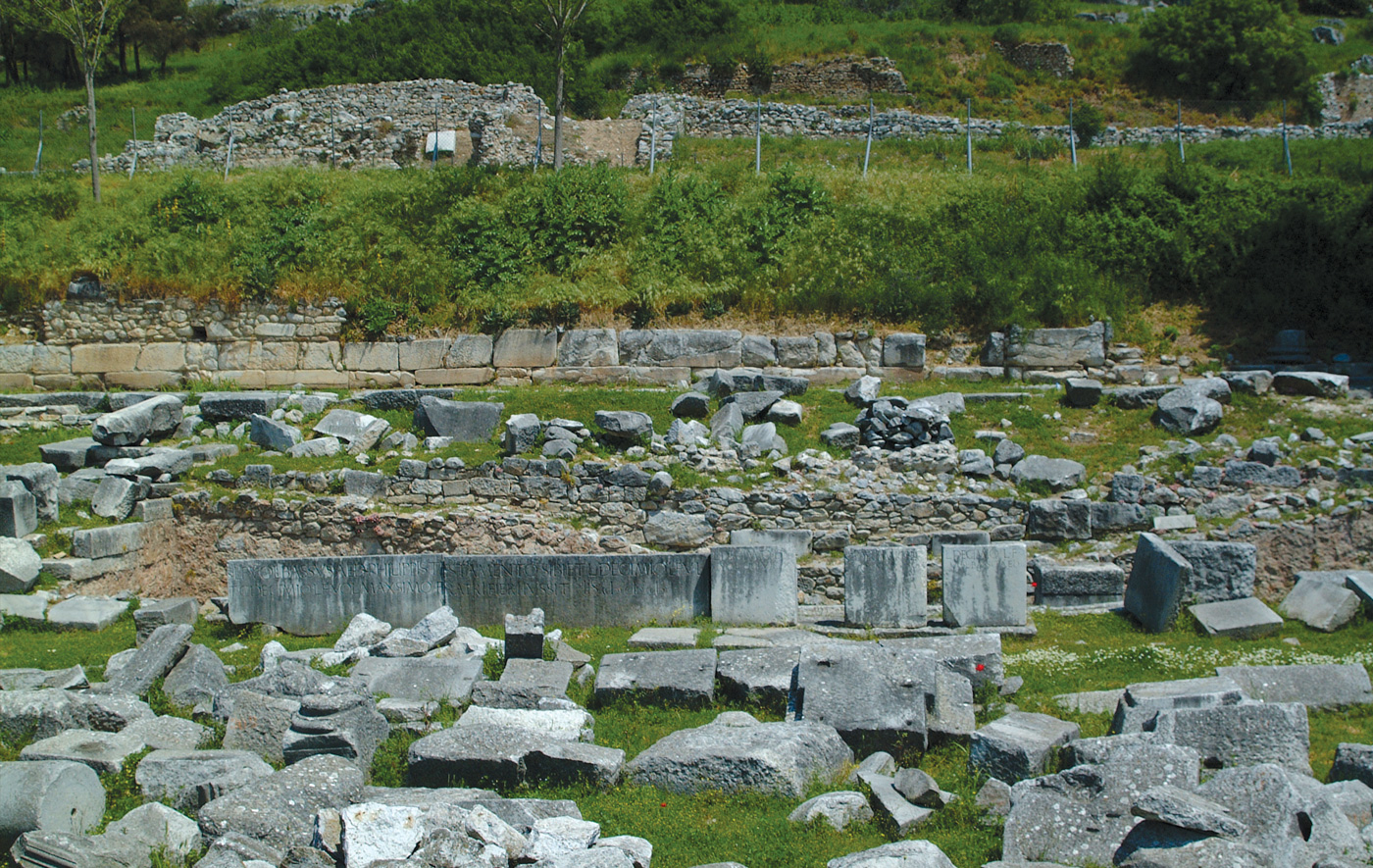
Date, Authorship, and Place of Origin
The traditional view is that Paul wrote the Letter to the Philippians from prison in Rome around the year AD 60. There is little reason to challenge this tradition, although several alternative locations have been suggested for the origin of the letter and for the city of Pauls imprisonment, suggestions that will be discussed below.
Few scholars have questioned Pauls authorship of Philippians. The letter opens with the greeting from Paul and Timothy, but it is clearly Paul alone who has actually written the letter. Timothy might have been Pauls secretary or companion, but he is not a coauthor. His name appears again only in 2:19, whereas the first-person singular pronouns I, me, and my appear over fifty times. Both the biographical section and the theology are consistent with what we know of Pauls theology elsewhere in the New Testament, and from the earliest church fathers on, Paul has been considered the author of Philippians.
The date of Philippians is dependent on the decision about the letters place of origin. It is clearly written from prison, so the question becomes, During which of Pauls imprisonments did he write the Letter to the Philippians? Although several locations have been suggested, only two deserve serious consideration, since Acts records only two places where Paul was imprisoned: Caesarea (5859) and Rome (6062).
The text of Philippians offers several clues about where and why Paul was imprisoned: it appears that Paul was in prison facing a trial that could end in death or acquittal (1:1924; 2:2324), that he planned to visit Philippi upon his acquittal, that there were members of the praetorian guard (1:13 NASB, RSV; NIV: palace guard) and Caesars household (4:22) where he was being held, that Timothy was with Paul, that trips were being made between Philippi and the place where Paul was being held, and that extensive evangelistic efforts were being carried out in the city where Paul was being held.

